Public Hearing on Land Use Ordinance Gets People Talking about Bar Harbor's Success Ladder
Others worry about the impact of homes expanding into Town Hill
BAR HARBOR—Worries about how housing development might impact the character and water table of Town Hill, whose responsibility it is to find homes for others, and that potential land-use ordinance changes are too business-centric were the concerns of some of the twenty or so in-person attendees at a Bar Harbor Planning Department listening session on February 1. Some of those attending were Planning Board members.
The session’s purpose, according to Bar Harbor Planning Director Michele Gagnon, was to explain the four land use amendments and answer questions.
“We’re here to really have a conversation as much as possible,” Gagnon said.
While some worried that the land use amendments are too business focused, only one directly deals with employee housing. The others are for shared accommodations (which has no required employer component), to abide by new state rules meant to encourage residential housing, and one that would tweak how the Design Review Board works.
Three amendments are part of a bigger plan for the town’s housing needs. The expansion of where employee living quarters and shared accommodations could be built (if passed by voters) was initiated originally when the Bar Harbor Farm asked for changes so that it could house some of its workers on site. The farm is located in Town Hill.
Most of the discussion centered around the expansion of two home types into districts outside of downtown Bar Harbor.
“The goal of these amendments is to help balance the year round and seasonal housing needs,” Housing and Community Planner Cali Martinez said. “The goal of the strategies is to protect the current residents and the future residents.”
Architect Stewart Brecher said that the proposed amendment’s fatal flaw is that it is encouraging a physical housing type that can’t change. He said a more flexible solution would be increasing density via traditional apartments and he worried that the shared accommodation style would encourage residents to have no life outside the buildings.
Planning Board Secretary Elissa Chesler said that as a former resident of a shared-accommodation style home in Bar Harbor, her worry is that there is currently no bottom rung in the success ladder of Bar Harbor. She works at JAX and lives in the Frenchman Hill subdivision.
“For young people that are single, it is impossible at an entry level job—to pay $2,000 for a full apartment in this town,” Chesler said. “This is a type of housing that’s not just being built for the convenience of the employer, but for someone just getting started.”
There were concerns about how additional homes might impact the wells in Town Hill, which they said are already running dry. Others worried about whose responsibility it is to find homes for others, or what it wound mean to allow more development and density in areas to help promote building those homes. Some worried that their district in Town Hill is zoned for business uses such as auto repair.
And some asked what the focus and priority is for the town: creating and sustaining housing for people who have been here for fifty years, young families, people who are working at the hospital and labs, or is it to provide more housing so that people who have expanded their businesses can have more housing in the summer?
“That’s what it’s appearing to us,” Ellen Grover said.
Martinez said that a business that has made use of shared accommodations is the MDI Hospital.
“We need housing at all price points,” Gagnon said. Maine has one of the oldest housing stocks in the United States, she said. But these potential amendments are not meant to be the entire solution to the housing problem; it’s a part of the solution, but not all the solution, she stressed.
THE AMENDMENTS:
The volunteer Planning Board and town’s Planning Department have been working for months on three of the proposed amendments to the town’s Land Use Ordinance. The town’s volunteer Design Review Board has been working on another proposed amendment.
The town’s Land Use Ordinance creates the rules for development for the town.
Any change to that ordinance would have to be approved by the voters in June 2024.
According to a notice of public hearings, the employee living quarters amendment “would rename the existing employee living quarters use, allowed in 14 districts, to “employee living quarters-I.”
Employee living quarters-I would be allowed in 11 zoning districts. The amendment would also create a new use called “employee living quarters-2,” which would be allowed in 13 zoning districts. Employee living quarters-2 would be subject to Bar Harbor’s general review standards, in addition to certain design standards and density bonuses (lot coverage bonus). The definition of family would also be changed.”
According to that same notice for shared accommodations, “This amendment would increase housing opportunities by allowing more types of shared accommodations in 10 zoning districts where that use is not currently allowed. Shared accommodations is a housing type that includes individual rooms with shared dining facilities.”
“Housing Opportunities: This amendment is necessary to comply with LD 2003 and LD 1706. It is part of a statewide effort to increase housing units by requiring municipalities to remove some regulatory barriers to housing production. It allows for a density bonus of 2.5 times the base density for affordable housing developments in certain areas. It generally allows between two and four housing units per lot where housing is permitted, as well as allowing accessory dwelling units to be located on the same lot as a single-family home, under certain conditions.
“Furthermore, the amendment would delete Bar Harbor’s ‘bonus dwelling unit’ use because LD 2003 requires a comparable but more permissive use, referred to as accessory dwelling units. The amendment would also prohibit dwelling units expressly created under these provisions to be registered and/or used as short-term rentals.”
Design Review Board process and definitions
“This amendment would:
Update some properties names in Appendix A — Historic Properties in Design Review Overlay District;
Amend a definition related to signage review;
Simplify the review process for signs;
Adjust the Design Review Overlay district boundaries and area names;
Minimize redundancy by removing Appendix B — Locally Significant Properties in Design Review Overlay District and all reference to it;
Allow more time for the Planning and Code Department to review Design Review Board applications.
LINKS TO LEARN MORE
A more detailed explanation of the amendments is below.





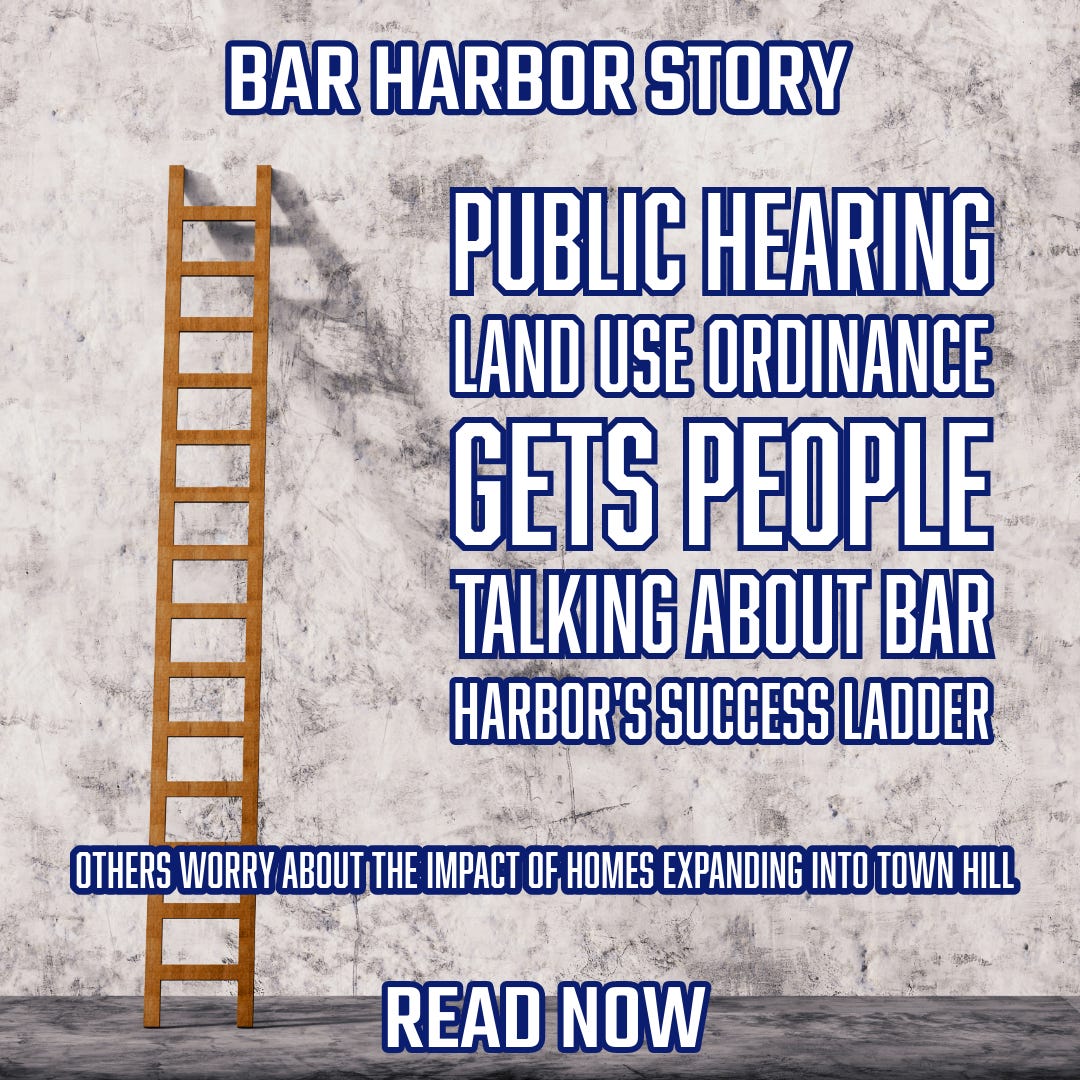
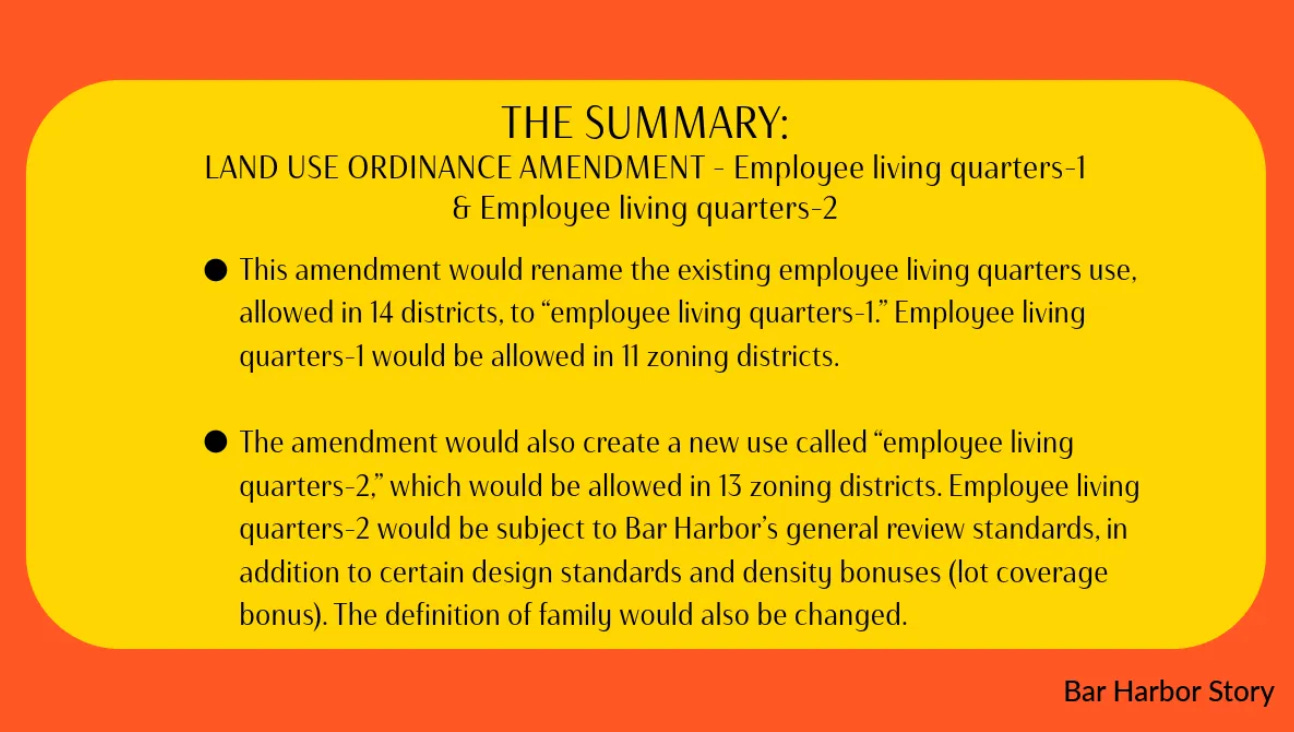
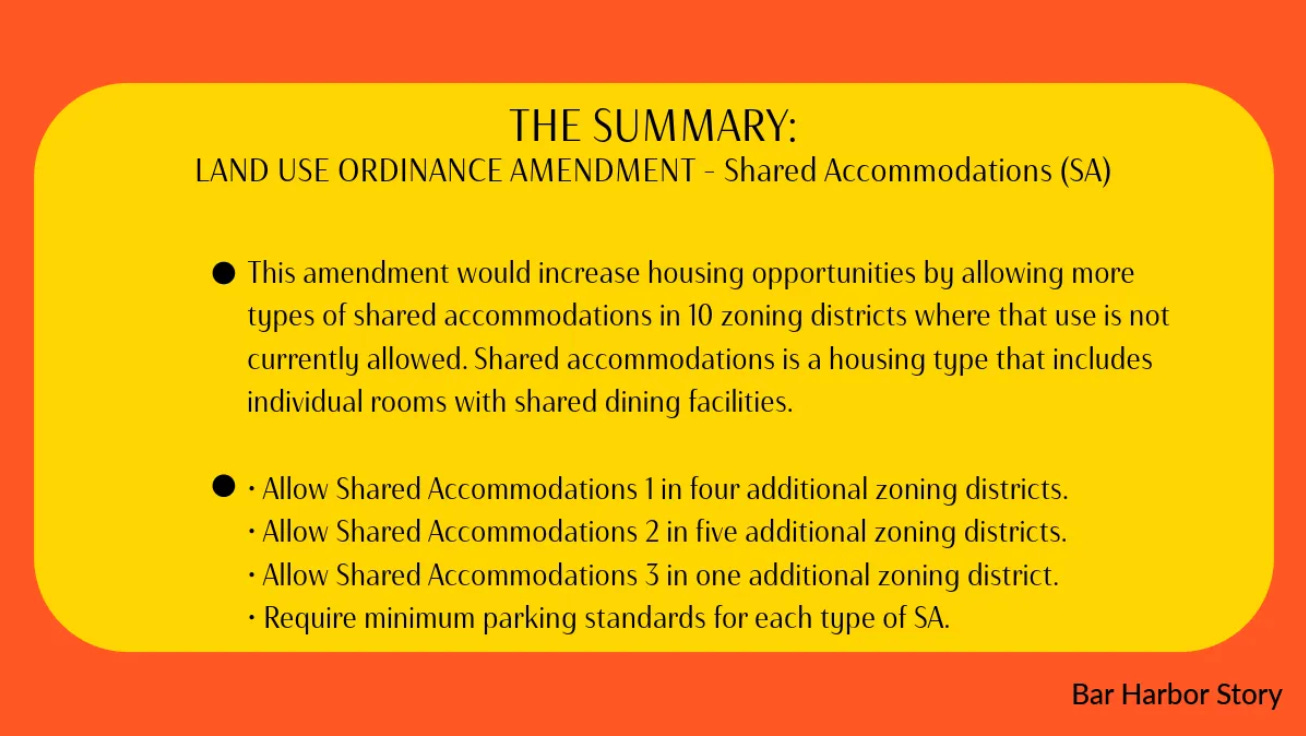
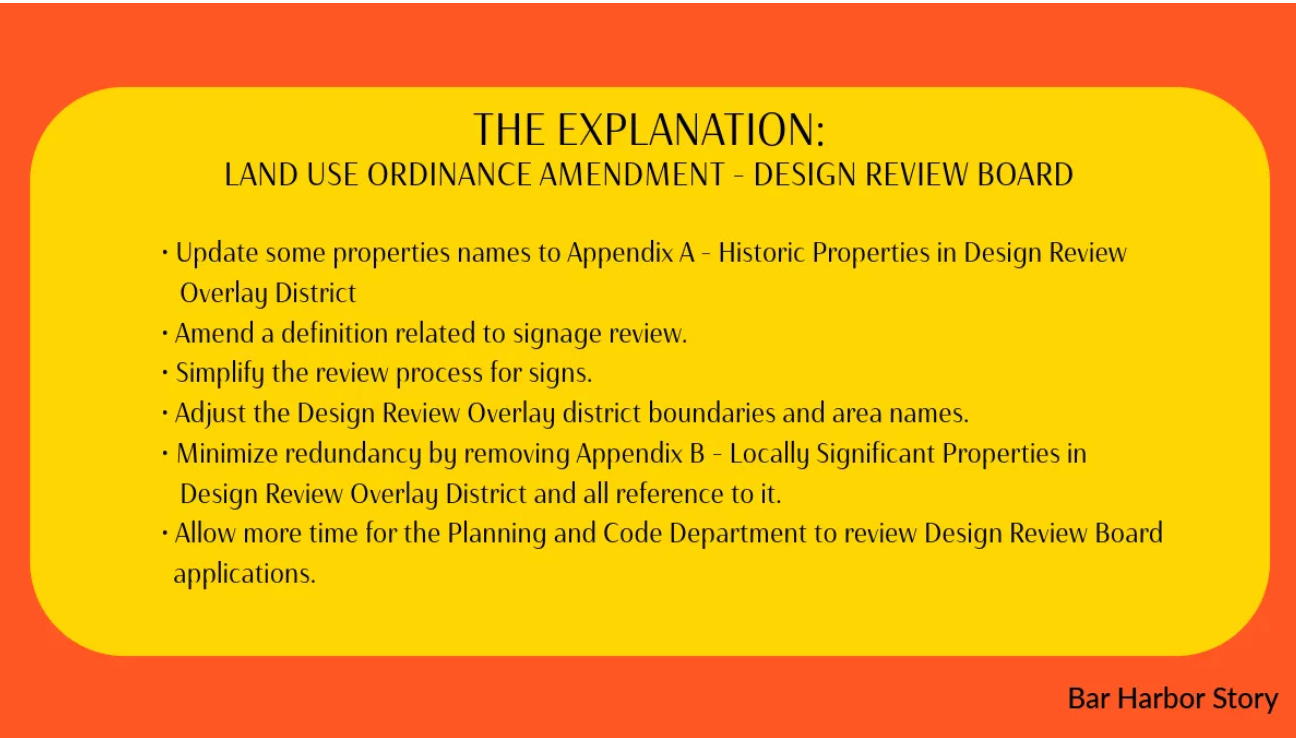
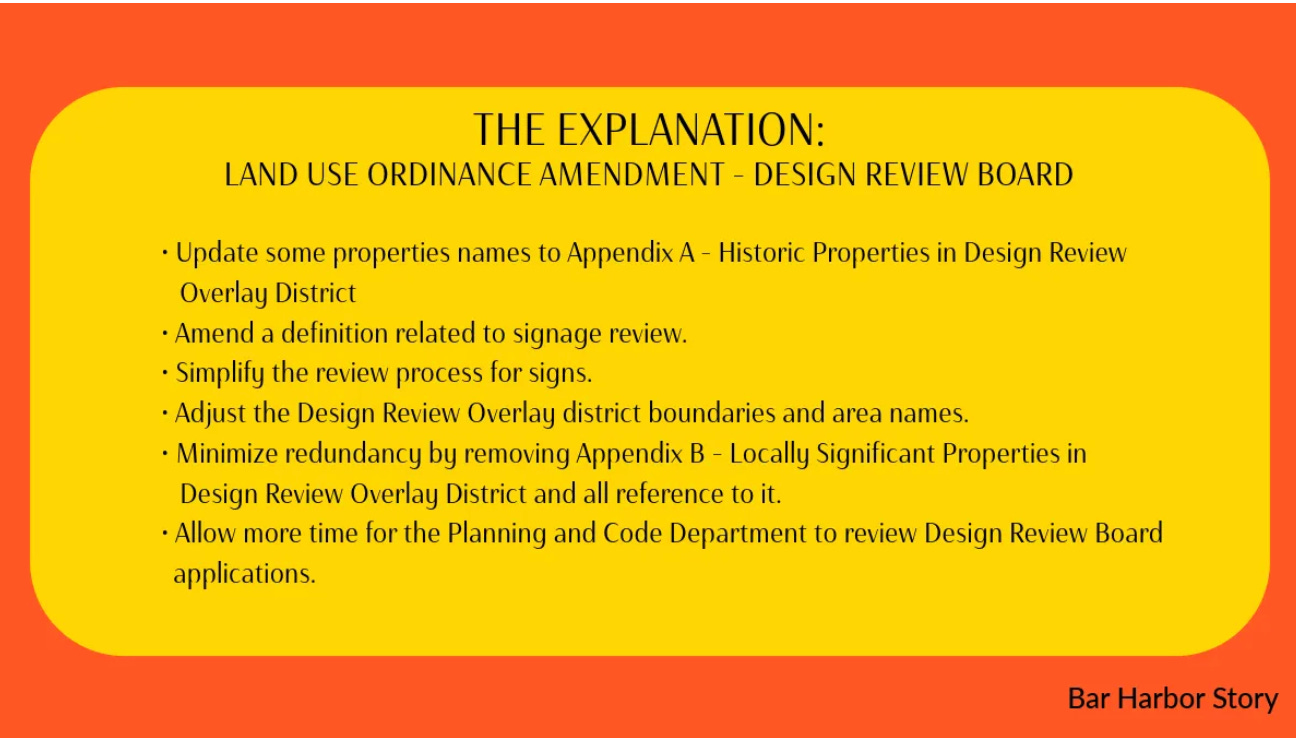
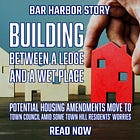
I wonder how these lot coverage amendments would impact existing subdivisions that have restrictive covenants that currently only allow one dwelling unit?